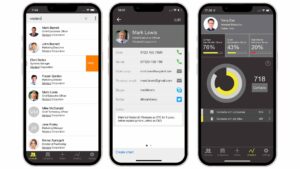From the many sales qualification frameworks in use across the sales profession, we think these 5 are the best. First though, let’s make sure we understand what sales qualification is and why it’s essential.
What is sales qualification?
Before a customer becomes a customer, they’re a prospective customer, or a ‘lead’, as often called in Sales. A lead can turn into an opportunity and an opportunity can turn into a customer. To say an opportunity is qualified, is to confirm that a product or service is a good fit for a customer. Therefore, sales qualification is the act of assessing or ‘qualifying’ the fit.
What is a sales qualification framework?
A sales qualification framework helps a sales professional assess whether a product or service is a good fit for a customer applying a set of fixed criteria. In the early stages of a sales cycle, a sale professional will perform a discovery call where they qualify whether there is fit. The outcome of the discovery call often decides whether the lead is qualified in or qualified out. Making the right decision is not always immediately obvious, which is where sales qualification frameworks come in. A sales qualification framework helps sales professionals determine whether there is fit and whether the relationship should continue.
Why use a sales qualification framework?
Not every lead is worth investing your time in, as not every lead is going to be a good fit for your product or service. Sales qualification allows you to quickly differentiate between prospects with a low or high fit. Knowing which leads have the potential to become a future sale helps sales people allocate their time better. Once a lead is qualified using a framework, it’s easier to predict the closing timeline and forecast sales revenue more confidently and accurately.
What sales qualification frame works can I use?
1. BANT
Developed by IBM in the 1960s, BANT is often described as the old faithful of sales qualification frameworks, yet many modern sales leaders argue that it’s outdated and self-serving. BANT was created to help IBM qualify leads out, as they were overwhelmed with inbound enquiries.
BUDGET: Is the prospect capable of buying.
- Do you have a budget set aside for this purchase? – What is it?
- Is a business case needed to create a budget?
AUTHORITY: Does the contact have the authority to sign off the deal.
- Whose budget will the purchase use?
- Who else will be involved in the purchasing decision?
- Have you made purchasing decisions for similar products?
NEED: What’s the business pain your solution solves.
- What challenge does this purchase solve?
- Why do you feel it’s worth solving?
- Why hasn’t it been addressed before?
TIMELINE: When is the prospect planning to buy.
- When do you need a solution in place by?
- Are there any competing priorities
2. CHAMP
Often described a modern version of BANT, CHAMP is focused on qualifying leads in rather than qualifying them out. Users of CHAMP ask their prospect questions about challenges they are experiencing, meaning a need or pain the prospect is experiencing.
CHALLENGES: What challenge is the prospect facing.
- What’s driving your interest in our solution?
- What challenges you looking to solve with this solution?
- What are the consequences if the pain is not solved?
AUTHORITY: Who’s involved in the decision-making process.
- Who’s involved in buying a solution like this at your company?
- How are purchasing decisions made for products like ours?
MONEY: Does the prospect have a budget for the project.
- Do you have budget allocated to the project?
- What is your typical budget allocation process?
- Is this an important enough priority to allocate funds?
PRIORITISATION: How important or urgent is the purchase.
- Do you currently have a contract? When is the renewal?
- What are the implications if you don’t solve the problem?
- What is a realistic timeframe from right now to contract signature?
3. SCOTSMAN
SCOTSMAN was created by the Advanced Selling Skills Academy and is one of the most rigorous qualification frameworks available as it qualifies competition in the sales process
SOLUTION: What is the value of our product or service relative to the clients needs? e.g. it saves them money, prevents risks, creates sales.
COMPETITION: Who are we competing with, including any incumbent.
ORIGINALITY: What unique benefits does my product/service offer that my competition doesn’t?
TIMESCALE: What is the client’s timescale? How can we influence them
SIZE: What is the scope of the opportunity? e.g. how many sites/licenses/users required
MONEY: Does the client have the budget required?
AUTHORITY: Who is the budget holder? Who is the decision maker?
NEED: Does the client recognise a need for our solution?
4. FAINT
A framework designed for use with early stage concepts usually on the innovation or early adoption phase of the product life cycle.
FUNDS: The initial focus is on organisations that have the financial capacity to buy. There may not be a budget today, but they have the financial wherewithal to spend.
- If we could prove ROI, do you have the capacity to buy in the next 6 months?
- If the solution could save you £100k a year, would you be able to generate a budget for it?
AUTHORITY: The goal is on finding individuals who are budget holders or decision makers that have the authority to allocate said funds.
- Whose budget do you think this could come from?
- Suppose the budget was created, would you be one of the decision makers in signing the contract?
INTEREST: Focus on generating interest from the buyer on achieving a future reality that is better than the one they have today.
- Say the budget did exist, if I could solve this pain would it make your life easier?
NEED: Identify the most specific problem the solution solves.
- What business problems would the solution solve?
- Why do you feel the problem needs to be solved?
TIMING: The goal is to establish and agree upon a future timeframe to implement the solution.
- What’s the latest date you would like to start tackling the problem?
5. MEDDPICC
Originally pioneered by sales authors Dick Dunkel and Jack Napoli, MEDDPICC is now the most progressive sales qualification framework on the planet, popularised by best selling sales book: A Qualified Sales Leader by 5 times CRO John McMahon. The framework focuses on champion building and measuring the benefit of change.
METRICS: The quantified business benefit of change. e.g. buying the solution will save us £250,000 a year.
ECONOMIC BUYER: A contact or committee that has the overall authority over the buying decision. The Economic Buyer (EB) can say “no” when others say “yes’ and say “yes” when others say “no”.
DECISION PROCESS: The individual milestone stages from evaluation to decision.
DECISION CRITERIA: The required capabilities for the purchase i.e. a prioritised shopping list.
PAPER PROCESS: The individual milestones stages between receiving a positive decision to buy and signing the contract.
IDENTIFY PAIN: The problem and business impact driving the need to make the purchase.
CHAMPION: A contact with influence over the EB, who sells internally on your behalf and has a vested interest in your success.
COMPETITION: The competition the opportunity can be lost to including the incumbent or do nothing.
Conclusion
BANT has been around for many a decade. It works reasonably well for inbound enquiries, but is next to useless in an outbound motion or in a saturated market. Asking budget questions straight out of the gate, is the best way to scare your prospect away. CHAMP is an improvement, and works well to shift the focus to what the client cares about. BANT, CHAMP and FAINT all completely ignore the reality of having competition.
From the 5 frameworks we’ve short listed, we think the longer frameworks SCOTSMAN and MEDDPICC are the best, as they allow each stage to put a deeper focus on each individual stage of qualification. Due to its focus on qualifying the quantified business benefit of change, and the microscopic focus on timescales both before and after a Yes is given, MEDDPICC is our winner! MEDDPICC is the framework that gives the most benefit to the customer in validating their buying decision and the best framework for the sales person for achieving accuracy in sales forecasting.
Advice
Information doesn’t always come in the first meeting or from the first person you speak to you. Information is often presented in a non-linear format. Therefore, you could be at risk of missing key information if you don’t apply flexibility to your approach. With any of these frameworks, nothing is stopping you from qualifying out of sequence. In larger organisations where internal politics is more abundant, relationship mapping software like ContactBase can help you identify Economic Buyers and Champions.
Above all, any sales qualification framework is only as good as the response your questions evoke. When using any sales qualification framework, the key to qualifying with conviction is to always ask questions with genuine interest and ensure you listen actively. You must care about your prospects and always do the right thing by them. If the product isn’t right for them, then just qualify it out and move on to the next. Take an honest approach built on integrity and your sales numbers will follow.








